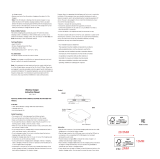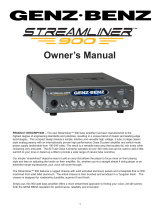SAFETY INSTRUCTIONS
Caution: To reduce the risk of electrical shock, do not remove the
cover as there are no user serviceable parts inside. Refer servicing
to qualified personnel.
This symbol, wherever it appears, alerts you to the presence of noninsulated
dangerous voltage inside the enclosure - voltage that may
be sufficient to constitute risk of shock.
This symbol, wherever it appears, alerts you to important operating
and maintenance instructions in the accompanying literature. Read
the manual.
WARNING!
This amplifier is capable of producing high sound pressure levels. Continued exposure to these high sound pressure levels
can cause permanent and irreversible hearing damage. Ear protection is recommended if unit is operated at high volume for
long period of time. If you experience any hearing loss or ringing in the ears you should consult a doctor.
IMPORTANT SAFETY INSTRUCTIONS
1. Read these instructions
2. Keep these instructions
3. Heed all warnings
4. Follow all instructions
5. Do not use this apparatus near water
6. Clean only with dry cloth.
7. Do not block any ventilation openings. Install in accordance with the manufacture’s instructions.
8. Do not install near any heat sources such as radiators, heat registers, stoves, or other apparatus
(including amplifiers) that produce heat.
9. Do not defeat the safety purpose of the polarized or grounding plug. A polarized plug has two blades with one wider
than the other. A grounding plug has two blades and a third grounding prong. The wide blade or the third prong is
provided for your safety. If the provided plug does not fit into your outlet, consult an electrician for replacement of the
obsolete outlet.
10. Protect the power cord from being walked on or pinched particularly at the plugs, convenience receptacles, and at the
point where they exit from the apparatus.
11. Only use attachments/accessories specified by the manufacturer.
12. Use only with the cart, stand, tripod, bracket, or table specified by the manufacturer, or sold with
the apparatus. When a cart or rack is used, use caution when moving the cart/apparatus
combination to avoid injury from tip-over.
13. Unplug the apparatus during lightning storms or when unused for long periods of time.
14. Refer all servicing to qualified personnel. Servicing is required when the apparatus has been damaged in any way,
such as power supply cord or plug is damaged, liquid has been spilled or objects have fallen into the apparatus has
been exposed to rain or moisture, does not operate normally, or has been dropped.
6





















